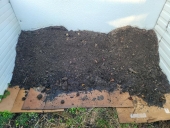layers, layers, layers...
The weather here changes so often, I make sure I wear layers upon layers so I can remove some if needed. Like today, it's starting out around 38 degrees Fahrenheit (3.3 C) and is supposed to get into the mid-60s (15.5+ C) with lows at night in the 20s. And who knows, we may have some rogue snow storm move in randomly.







